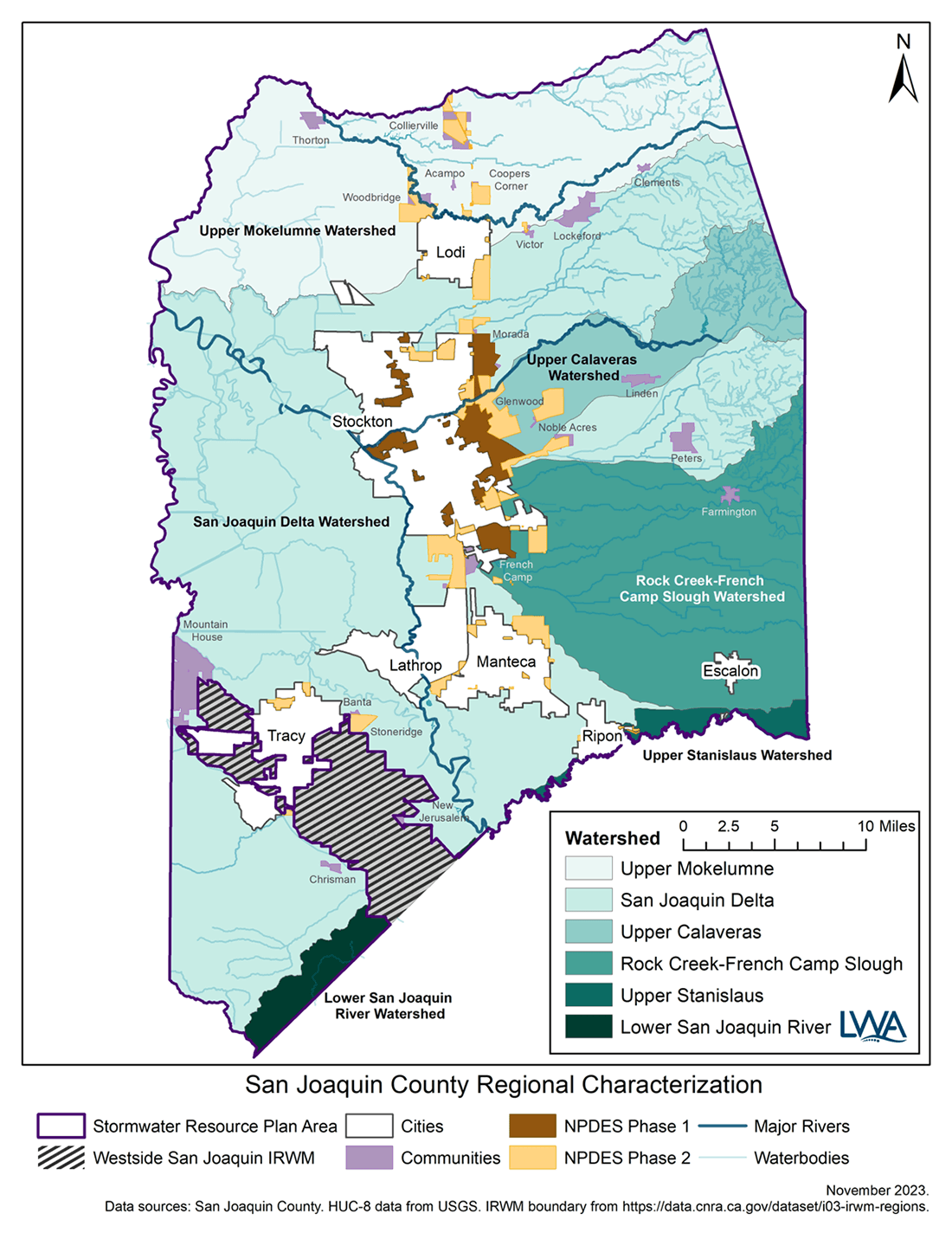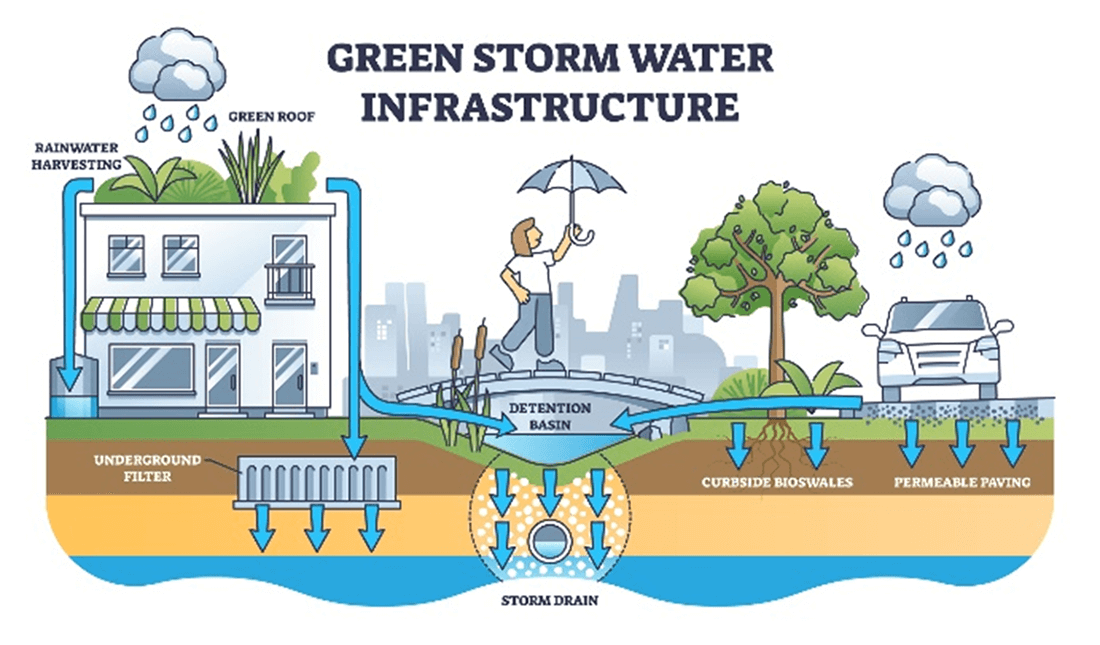Regional and Tribal Engagement
What is a stormwater resource plan (SWRP)
A Stormwater Resource Plan (SWRP) is a planning document that identifies and prioritizes projects focused on the sustainable management of stormwater and dry weather runoff. These projects (also referred to as green infrastructure projects) can provide multiple benefits including improved regional water quality, reduced localized flooding, increased water supplies, and community enhancement.
A project must be included in the SWRP document to be eligible to receive State grant funding (with few exceptions; see Footnote 1). Projects can be submitted to be included in the SWRP by regional and Tribal governments, public agencies, 501(c)(3) nonprofit organizations, public entities, non-municipal public landowners, water companies, and the general public.
Once developed, the SWRP will include a list of potential stormwater projects that regional and Tribal governments and interested parties would like to include in order for those projects to become eligible to receive future State grant funding. This document and its list of projects can be updated in the future, to include new projects or to adjust the methodology used to prioritize projects.
The San Joaquin County Region SWRP
The San Joaquin County Region Stormwater Resource Plan (San Joaquin County SWRP) is being developed by the County of San Joaquin and cities of Stockton, Tracy, Lodi, and Manteca (participating agencies) to identify and prioritize stormwater and dry weather runoff capture projects.

How does STORMWATER impact WATER QUALITY?
Stormwater is runoff that can occur when there is rain or snowmelt. Likewise, dry weather urban runoff can occur when someone uses water and allows it to run off their property, for example when they are gardening, watering their lawn, or cleaning their car.
In natural or open space areas (e.g., parks, fields, gardens) stormwater and dry weather urban runoff can absorb into the ground. However, in areas where development has occurred, stormwater and dry weather runoff travels along impervious surfaces (e.g., rooftops, roads, and parking lots) and flows, untreated, into the local waterways. If the stormwater has picked up pollutants such as trash, chemicals, or sediment prior to discharging into a waterway, it can adversely affect the fish, aquatic insects and/or animals that rely on that waterbody.

How Can green infrastructure Projects Improve Water Quality?
Green stormwater infrastructure (GSI) is a type of development that uses natural materials (plants, soil, green space) or methods such as permeable pavement to absorb and filter storm water and urban runoff of pollutants. GSI helps to prevent flooding and pollution of local water bodies.
Types of GI include rainwater harvesting, rain gardens, planter boxes, green roofs, bioswales, permeable pavements, green streets and alleys, green parking, urban tree canopy, and land conservation.
GI features:
- Mimic natural systems to absorb and filter stormwater, which removes pollutants and slows or reduces runoff into storm drains and surface waters; and
- Can reduce erosion and flood risk, as well as protect water quality for humans and aquatic organisms.
For further information on green infrastructure, you can visit the following: https://www.epa.gov/green-infrastructure/what-green-infrastructure
Tribal Engagement
Tribal Engagement is important for the development and implementation of the Storm Water Resource Plan (SWRP). The agencies funding the development of the SWRP, namely the County of San Joaquin and the Cities of Lodi, Tracy, Manteca and Stockton, are committed to engaging with Tribal partners and developing partnerships. They are also focused on promoting collaborative and transparent Tribal engagement to ensure creation of the best Plan that meets Tribal Partner interests and benefits watershed sustainability.
Please contact Chris Boyer or Roy Valadez with the County of San Joaquin at cboyer@sjgov.org or rvaladez@sjgov.org if you are interested in getting involved in SWRP development or proposing a project for the SWRP. You can also reach them via phone by contacting the San Joaquin Water Resources Division at 209-468-3000.
We want to hear from you!
A core component of SWRP development is outreach and collaboration with all regional and Tribal governments, interested groups, and the public to identify and prioritize potential projects that could be included in the SWRP. We seek to include input and feedback from Native American Tribes and Tribal governments, public agencies, and regional interested parties including nonprofit organizations, public entities, watershed groups, non-municipal public landowners, and the general public.
During the development of the SWRP, which will take about 6-9 months to complete, there will be several opportunities for you to get involved. One of these opportunities will be for you to suggest ideas for green stormwater infrastructure projects.
Please refer to the Stages of Engagement table below to identify opportunities for you to get involved during the different phases of SWRP development. This table will be updated during each phase of engagement with guidance on how you can get involved. Please email rebeccas@lwa.com or karena@lwa.com to learn more about a specific Stage of Engagement or request further information or clarification.
| Stages of Engagement |
Timeline |
| Outreach with regional and Tribal governments and interested parties (we want to hear from you!) |
December 2023 - Ongoing |
| Review of a Methodology for Ranking Stormwater Projects |
March 13th |
| Opportunity for Your Project Submittal |
April 5 - April 29, 2024 |
| Review of the Draft SWRP |
June 28-July 19 |
| SWRP Modification/ Project Implementation (Ongoing) |
To be announced- 2024 |
Opportunity to Review the Draft SWRP
The Participating Agencies have developed a complete draft of the San Joaquin County Region Stormwater Resource Plan (SJC SWRP). The SWRP draft and all appendices can be downloaded here: here (SWRP Draft for download). The Participating Agencies have also developed a Comment Form for you to provide input and feedback on the SWRP, which can be downloaded here: Download Comment Form.
All are welcome to provide input, and we want your suggestions and feedback!
Your involvement is essential to developing a SWRP that benefits both environmental and community interests. If you are interested in reviewing the draft SWRP, please
- download the complete SWRP and its appendices from the link above
- download the Comment Form from the link above and use it to provide any comments, suggestions or feedback on the SWRP. There are two example comments in the form already, to show you the format we are looking for.
NOTE: for every comment/suggestion you enter in the form, please be sure to fill out the column that says “SWRP Document Section”. We will need this information to know which section of the SWRP you are commenting on. Please also be as specific as possible in your comments or edit suggestions.
- Once you have completed your review and filled out the comment form, please email your form to rebeccas@lwa.com or karena@lwa.com by no later than 5 PM PT on July 19th, 2024.
Footnote 1: “Exceptions where a SWRP is not required are: (1) for projects benefiting a disadvantaged community (DAC) with a population of 20,000 or less that is not a co-permittee for an MS4 permit issued to a municipality with a population of more than 20,000, and (2) for projects that are in an Area of Special Biological Significance (ASBS) and are covered under an approved ASBS Compliance Plan. If an applicant or project is exempt from the SWRP requirement, the project must still be included and implemented in an adopted Integrated Regional Water Management Plan (IRWMP)” (Source: California State Water Resources Control Board, Prop 1 Storm Water Grant Program FAQs Sheet, https://www.waterboards.ca.gov/water_issues/programs/grants_loans/swgp/docs/prop1/prop1_swgp_faq.pdf)